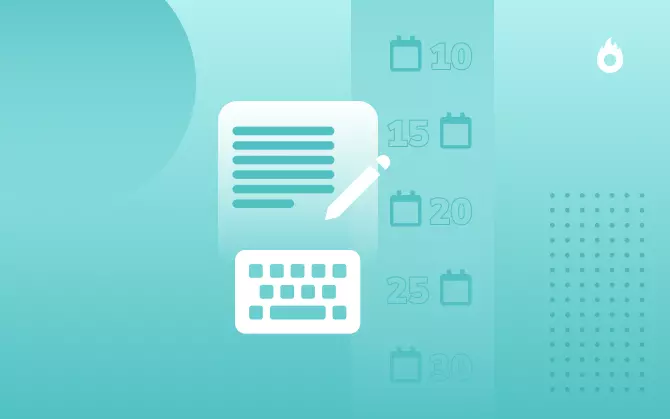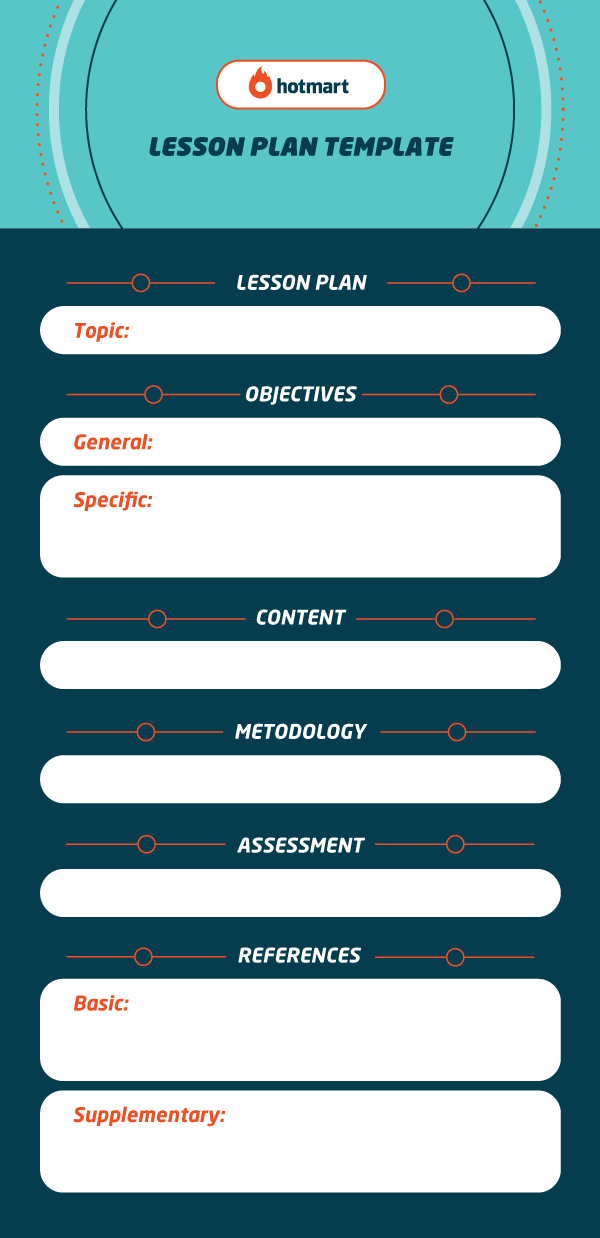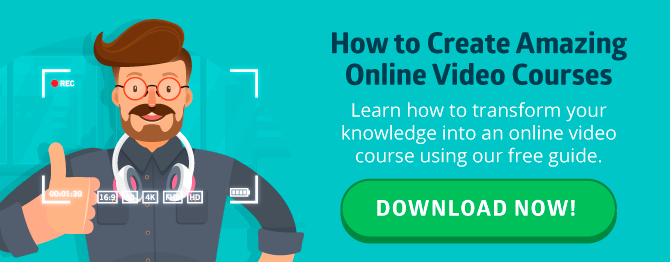
What Is a Lesson Plan and What Is Its Importance in an Online Course?
Check out the key elements to plan your classes.

What will we see in this post
A lesson plan is an essential resource for those who teach. The teacher needs to think about the course content in advance so that it will not only be a high-quality class, but especially so that it fits into the available timeframe.
Without planning, you may not have time to teach everything you meant to.
But don’t think for a second that this is only accurate for on-site courses.
When you create an online course, it is also very important to plan all classes that will be recorded. This way, you can follow a logical content sequence, in addition to adapting everything according to each video’s time.
If you’ve never thought about doing this type of planning before, keep reading this post and find out how to create a lesson plan for your online course.
Video: Make better online courses with lesson plan | Hotmart Tips

What is a lesson plan?
Teachers are quite familiar with lesson plans. They are a descriptive document that indicates everything a teacher needs to do during their classes. In other words, they are an activity and content-planning tool.
A teacher’s role is to convey as much knowledge as possible. So, there’s nothing better than relying on a planning tool that enables you to organize the content that will be taught in the most logical manner.
Unlike some may think, class plans are not fixed, i.e., they can be constantly updated, whenever necessary.
This flexibility is due to the fact that a class approach might change during the course and also because the planning is done before the course begins. So, perhaps what you’ve planned doesn’t work well with the class because of your personal characteristics.
However, in an online class, you cannot change your videos while the course is taking place.
But if you have an online lesson plan and realize that your audience isn’t enjoying how the content is being taught, you can make changes based on what you had previously planned.
Therefore, lesson plans work as a guide for teachers since they contain the steps to be followed during the course, the sequence of content to be taught, how each theme will be presented, the evaluation activities, evaluation methods, among other things you wish to add.
What is the importance of a lesson plan?
Lesson plans vary according to the type of content that will be taught, but their importance is the same for all courses, whether online or in person.
Check out the main advantages of using it:
1. It helps organize online classes
One of the main benefits of lesson plans is organization.
Quite some teachers get lost regarding the content to be taught, especially when classes are recorded and aren’t very long.
This document helps create a macro view of the course and not only of the separate parts.
In this manner, teachers are able to think more about the time for each content and also about the order in which each theme will be presented, since they will know precisely everything that needs to be taught even before they start recording their classes.
2. It provides resources and tools
With a lesson plan, teachers are able to understand which tools and resources are applicable to their material and when to use each of these options.
In online courses, digital tools are key because they enable students to understand the content well.
There are several educational technologies that can be employed by teachers in order to improve their online courses. If they only think about them at the time they are recording videos, they might face a major obstacle or even forget to use them.
It is a lot easier when you are able to predict the resources you will use, and a lesson plan is the ideal moment to think about it.
3. It facilitates the creation of scripts
Before creating an online course, it is necessary that you also prepare your script, in order to know exactly what you will say in each video.
With a lesson plan, you will have a basis for your script, since this document allows teachers to identify the goals of each online class.
Knowing what needs to be taught makes the creation of a script simpler when recording content.
4. It helps during class preparation
There’s no doubt that if you’re teaching a subject, it is because you know it well. But even so, preparation is essential even for those who master what they will teach.
Since lesson plans help teachers know what content they’ll teach their students, they can prepare even more.
It is possible to practice what you’ll say so that when it’s time to record the videos, you won’t waste time with extra recordings and the correction of mistakes.
In addition, teachers have more available time to research content, which makes it possible to add information beyond the basic, such as curiosities and other sources of study.
5. It enables possible changes
During the development of the online lesson plan, teachers might realize that certain points need to be reviewed, tools that need to be replaced, and a lesson that requires special attention.
With the document in hand, it is easier to make changes.
We need to remember that we are talking about distance education, in other words, you won’t have in-person contact with your students.
Therefore, planning must be increased and mistakes must be corrected beforehand.
VIDEO: How Billy Would Fix Education | Insights from Billy Gene | Cuts
How to set up your lesson plan
But after all, how do you create a good lesson plan?
From now on, we’ll show you the detailed process to develop a lesson plan for your online course.
You’ll see that these steps are quite simple, but they will serve as a guideline for practically your entire course planning.
1. Choose a theme
The first step when creating a lesson plan is defining your course’s theme.
It’s not possible to include several completely different contents or various courses in the same plan.
You should divide the course’s main theme into small parts, as if they were subjects or subtopics.
2. Define your goal
After establishing the lesson plan theme, it’s time to establish a goal, i.e., the purpose of the lesson.
Think about a goal related to the students, for example, the skill you expect to convey and the knowledge they need to acquire after watching your class.
You need to keep in mind the result you expect from your students in order to know the best approach for your class.
At this point, it’s important to be realistic, taking into account the time available for the lesson, the material available and your audience’s educational background.
3. Have a methodology
Methodology is nothing more than the path that’ll be used to reach the goal that you’ve set.
In order for the lesson plan to be developed, it is essential to keep in mind the path you will take to share your knowledge.
Basically, this is the moment in which you will decide if you will teach in person, online, by using videos, eBooks or audiobooks, for example.
4. Select the material
The selection of the material necessary for the development of the lesson plan is one of the most important steps.
In order to be able to define beforehand the resources you’ll use in your classes, such as ebooks, infographics, expository video classes, it is necessary to understand the audience you wish to reach.
Also, don’t forget that material selection should be related to the methodology and the purpose of the classes.
5. Establish a period
The period refers to the time interval reserved for each of the subtopics planned for your online course.
Remember that the time available for the presentation of content is limited, since your course must have an end. This is why it’s necessary to divide the time between classes.
In addition, also establish the time spent on each video class. Avoid very long or very short classes. Think about your content as a whole and divide in such a manner that it is well structured.
6. Think about ways to evaluate student progress
During the course, think about creating mechanisms to evaluate your students’ progress, and at the same time, the progress of the lessons themselves.
This evaluation helps you understand if the chosen methodology is truly efficient to ensure that students are learning what you are teaching.
7. Indicate references and supplementary material in your lesson plan
Finally, the lesson plan must also have a set of references for you as well as for your students.
Point out other sources in which your students can find further information the subject they’re studying, in addition to sources that you can use to research and delve deeper into the subject you’re teaching.
In order to make it more visual, we’ve created a lesson plan that you can use when you create your own. Check it out:

Create your online course
You saw that lesson plans are documents that guide teachers when it comes to organizing their lessons and therefore, help when creating an online course.
This document is crucial because once ready, it allows you to have a macro view of the entire content you’ll be teaching. In a few steps, it is possible to have an idea of everything you’ll need to start recording your lessons.
Take advantage of the free Hotmart guide to creating an amazing online video course and star now!






